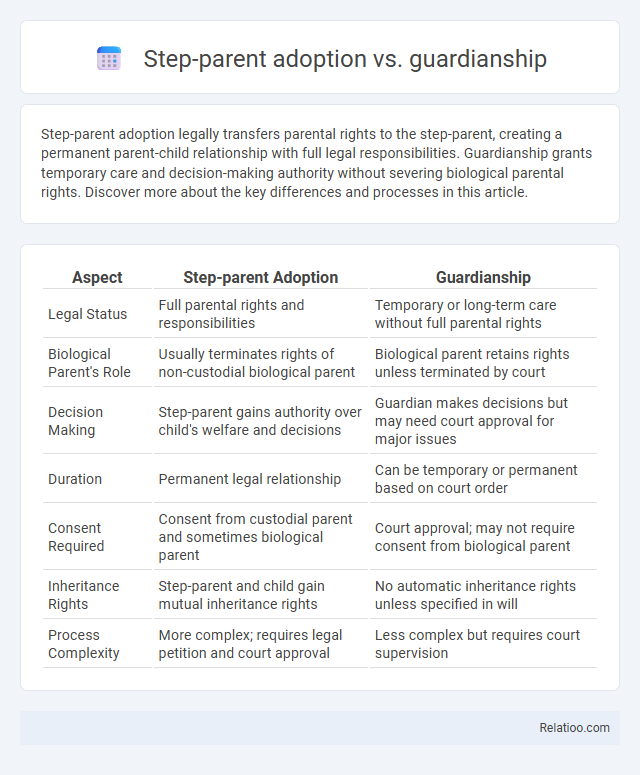Step-parent adoption legally transfers parental rights to the step-parent, creating a permanent parent-child relationship with full legal responsibilities. Guardianship grants temporary care and decision-making authority without severing biological parental rights. Discover more about the key differences and processes in this article.
Table of Comparison
| Aspect | Step-parent Adoption | Guardianship |
|---|---|---|
| Legal Status | Full parental rights and responsibilities | Temporary or long-term care without full parental rights |
| Biological Parent's Role | Usually terminates rights of non-custodial biological parent | Biological parent retains rights unless terminated by court |
| Decision Making | Step-parent gains authority over child's welfare and decisions | Guardian makes decisions but may need court approval for major issues |
| Duration | Permanent legal relationship | Can be temporary or permanent based on court order |
| Consent Required | Consent from custodial parent and sometimes biological parent | Court approval; may not require consent from biological parent |
| Inheritance Rights | Step-parent and child gain mutual inheritance rights | No automatic inheritance rights unless specified in will |
| Process Complexity | More complex; requires legal petition and court approval | Less complex but requires court supervision |
Understanding Step-parent Adoption
Step-parent adoption legally establishes your role as a parent, granting full parental rights that surpass guardianship or informal step-parenting arrangements. Unlike guardianship, which provides temporary or limited authority, step-parent adoption permanently transfers parental responsibilities and rights, securing your child's legal and emotional stability. Understanding step-parent adoption is crucial for ensuring your parental rights are recognized and your child's best interests are fully protected.
What is Legal Guardianship?
Legal guardianship grants you the legal authority to care for a child when the biological parents cannot fulfill their responsibilities, without terminating parental rights. Unlike step-parent adoption, which transfers parental rights fully to the step-parent, guardianship provides temporary or long-term care while maintaining the parents' legal status. Guardianship ensures the child's welfare and allows decision-making in education, health, and daily life, often used when adoption is not feasible or desired.
Key Differences Between Adoption and Guardianship
Step-parent adoption legally transfers full parental rights and responsibilities from the biological parent to the step-parent, establishing the step-parent as the child's permanent legal parent. Guardianship grants a caregiver temporary or long-term authority to make decisions for the child without terminating the biological parent's rights. Unlike guardianship, adoption provides the child with inheritance rights and a permanent parent-child relationship recognized by law.
Legal Rights and Responsibilities
Step-parent adoption grants the step-parent full legal parental rights and responsibilities, including decision-making authority and inheritance rights, effectively replacing the biological parent's legal standing. Guardianship provides temporary or limited legal custody and responsibility for the child without terminating the biological parent's rights, often requiring court approval for major decisions. Step-parenting, without legal adoption or guardianship, carries no automatic legal rights, leaving the step-parent dependent on the biological parent's consent for medical, educational, or other child-related decisions.
Process and Requirements for Step-parent Adoption
Step-parent adoption requires a formal legal process involving court petitions, background checks, and often the consent of the non-custodial biological parent, ensuring your legal relationship with the child is recognized. Guardianship provides temporary or long-term custody without terminating parental rights, generally requiring proof of inability of the biological parent to care for the child and court approval. Step-parenting involves no legal action or requirements, as it is a social role without legal custody or parental rights unless formal adoption or guardianship is pursued.
Process and Requirements for Guardianship
Guardianship requires a legal process where You must petition the court to gain authority over a minor, demonstrating that the child's welfare will be protected under Your care. The process involves background checks, home studies, and sometimes consent from the child's biological parents or termination of their rights. Unlike step-parent adoption, guardianship does not sever the legal rights of the biological parents but grants You temporary or permanent responsibility for the child's well-being.
Impacts on Parental Rights
Step-parent adoption grants you full legal parental rights, including decision-making authority and inheritance rights, permanently transferring parental responsibilities from the biological parent. Guardianship provides temporary legal authority over the child but does not terminate the biological parent's rights, often requiring court approval for major decisions. Step-parenting without legal action carries no parental rights, limiting your ability to make official decisions or access medical and educational information.
Long-term Effects on the Child
Step-parent adoption grants the child full legal ties to the step-parent, ensuring inheritance rights and long-term security in parental decision-making. Guardianship provides temporary or conditional care without severing legal ties to the biological parents, which may create uncertainties about the child's future stability. Your choice impacts the child's emotional well-being, legal protection, and sense of family permanence, with step-parent adoption offering the most enduring benefits.
Financial and Inheritance Considerations
Step-parent adoption legally establishes you as the child's parent, granting full inheritance rights and access to benefits like Social Security and healthcare, unlike guardianship, which only provides temporary care without automatic inheritance or financial entitlements. Guardianship allows you to manage the child's financial and medical affairs but does not confer parental status, limiting access to benefits and inheritance protections. Step-parenting without legal adoption leaves the biological parent as the sole legal guardian, often complicating inheritance claims and financial responsibilities for your stepchild.
Choosing the Best Option for Your Family
Step-parent adoption provides permanent legal parental rights, ensuring your stepchild's full inheritance and support rights, while guardianship offers a temporary or conditional caregiving arrangement without changing parental rights. Step-parenting involves daily caregiving and emotional support but lacks legal authority unless formalized through adoption or guardianship. Choosing the best option for your family depends on your long-term goals for legal security, inheritance, and decision-making authority concerning your stepchild's welfare.

Infographic: Step-parent adoption vs Guardianship
 relatioo.com
relatioo.com